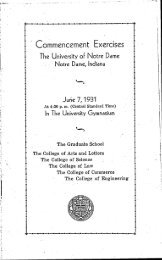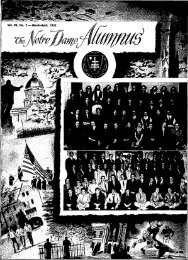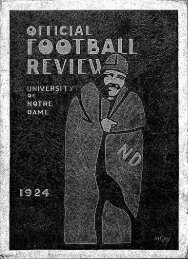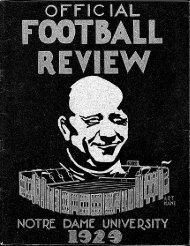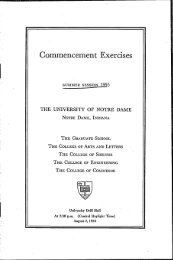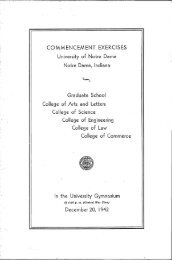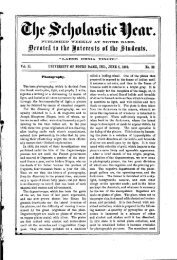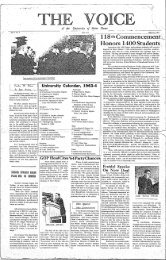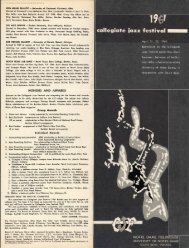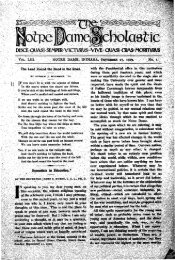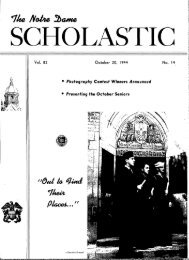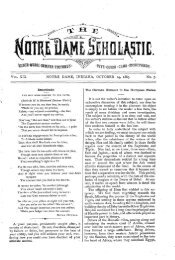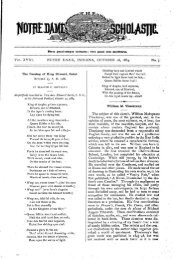Notre Dame Scholastic, Vol. 89, No. 26 - Archives - University of ...
Notre Dame Scholastic, Vol. 89, No. 26 - Archives - University of ...
Notre Dame Scholastic, Vol. 89, No. 26 - Archives - University of ...
You also want an ePaper? Increase the reach of your titles
YUMPU automatically turns print PDFs into web optimized ePapers that Google loves.
Research Program Produces Techniqi lue<br />
for Tapering Molten Nylon Bristles<br />
Difficult mechanical problems<br />
solved by Du Pont chemists<br />
and engineers to make nylon<br />
paintbrushes practicable<br />
Nylon bristles used in toothbrushes and<br />
hairbrushes are uniform in diameter—<br />
that is, they are "level." But paintbrushes<br />
made from such bristles did<br />
not paint well. Studies <strong>of</strong> the best natural<br />
bristles showed that they were tapered,<br />
so a research program to produce<br />
tapered nylon bristles was started.<br />
Some difficult mechanical problems<br />
were encountered. Level brush bristles<br />
were being made by extruding molten<br />
nylon through spinneret openings designed<br />
to produce filaments <strong>of</strong> perfectly<br />
uniform diameter. A new technique had<br />
to be found to make tapered ones. Since<br />
it was not practical to taper the filament<br />
after coohng and drawing, a precise<br />
taper had to be put in just as the<br />
nylon emerged molten from the spinneret.<br />
And it had to survive the drawing<br />
operation, in which nylon is stretched<br />
to several times its original length!<br />
Techniques originated in laboratory<br />
The original idea for solving this problem<br />
came from Du Pont chemists, who<br />
WATER BATH'<br />
^ ^ ^<br />
worked out the techniques in the laboratory,<br />
in the somewhat crude form<br />
represented in the accompan3ring diagram.<br />
It being largely a mechanical<br />
problem, chemical and mechanical engineers<br />
were called in to cooperate soon<br />
after the studies got under way. After<br />
further laboratory development, the<br />
engineers put the operation on a production<br />
basis.<br />
The final result was a highly efficient<br />
process for tapering nylon bristles. As<br />
the molten filament emerges from the<br />
spinneret, pinch-rolls driven by a series<br />
<strong>of</strong> gears pull it slowly, then quickly.<br />
The size <strong>of</strong> the filament varies with the<br />
speed <strong>of</strong> pulling—thick diameters resulting<br />
at slow speeds and thin diameters<br />
at fast. Next the nylon goes to<br />
the drawing operation, where it is<br />
stretched by rollers to give it strength<br />
and resiliency.<br />
Engineers designed special machines<br />
Following spinning and drawing, in<br />
which many filaments are handled simultaneously,<br />
the nylon is "set." Then<br />
it goes to a special machine, designed<br />
by Du Pont engineers, which "feels<br />
out" the crests and troughs and cuts<br />
the bristle at these points. This tjrpe <strong>of</strong><br />
design was necessary because <strong>of</strong> the unavoidable<br />
small variations in the length<br />
<strong>of</strong> individual bristles. Sorting the bris-<br />
ENLARGED VIEW<br />
OF TAPERED FILAMENT<br />
textseciurat<br />
Diagrammatic represenfation <strong>of</strong> the first laboratory apparatus used to establish the principle <strong>of</strong><br />
making nylon from molten plastic. (From an early potent.)<br />
Present state <strong>of</strong> development <strong>of</strong> tlie "spin-draw"<br />
machine evolved from the crude laboratory<br />
apparatus shown in the diagram below.<br />
ties and sandpapering their ends completes<br />
the process.<br />
Many techniques contributed to the<br />
development <strong>of</strong> the optimiun properties<br />
<strong>of</strong> nylon in tapered bristles. At the laboratory<br />
stage, x-ray studies were made<br />
to learn the effect <strong>of</strong> various degrees <strong>of</strong><br />
crystalization on bristle drawing and<br />
setting. Niunerous devices were designed<br />
to test the bristles—for example, a machine<br />
that simulates the abrasive effect<br />
on a brush swept back and forth over a<br />
surface. Even after manufacture was<br />
established, high-speed stroboscopic<br />
photography and other stroboscopic<br />
studies were employed to improve coordination<br />
in the various operations<br />
and make a more uniform product.<br />
The development <strong>of</strong> these bristles<br />
furnishes another striking example <strong>of</strong><br />
the great variety <strong>of</strong> problems, <strong>of</strong>ten<br />
intricate, that may arise out <strong>of</strong> the discovery<br />
<strong>of</strong> a new substance like nylon.<br />
Questions College Men ask<br />
about working with Du Pont<br />
What are the opportunities<br />
in development work?<br />
The conception <strong>of</strong> an idea in a research<br />
laboratory is merely the starting point at^<br />
Du Pont. Men with training in mechanical,<br />
electrical, metallurgical, and chemical engineering<br />
are required to demonstrate the<br />
practicality <strong>of</strong> the laboratory findings, including<br />
small-scale operation <strong>of</strong> the new<br />
process. Even after the full-scale plant is<br />
operating, development work is continued<br />
to improve efficiency. Write for booklet,<br />
"The Du Pont Company and the College<br />
Graduate," 2518-A Nemours Building, Wilmington<br />
98, Delaware.<br />
BETTER THINGS FOR BETTER LIVING<br />
...THKOUGH CHEMISTKY<br />
More facts about Du Pont—Listen to "Cavalcade<br />
<strong>of</strong>Ameria^' Monday Nights, NBC Coast to Coast



